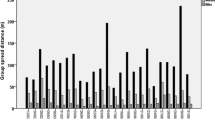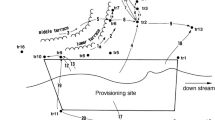Abstract
The average frequencies of communicative behavior, social behavior, and social encounters (inter-individual proximity within three meters) per hour for a monkey were obtained in their natural habitat by tracing several adult males and females of a Japanese monkey troop living in the Koshima islet. The spatial distribution patterns and the density of troop members within the expanse of the troop at any moment were investigated by tracing several adult femals. Frequency distributions of the monkeys found within five and 10 meters were compared with a Poisson distribution. The frequencies of social encounters and of social interactions of Japanese monkeys were distinctly low, except between mothers and their offspring. The density of monkeys within the expanse of the troop at any moment was very low. Both aggressive behavior and inter-individual proximity (within three meters) were distinctly low when monkeys were foraging for natural food. An avoiding mechanism among troop members plays an important role in maintaining the social structure of these Japanese monkeys. This mechanism works in two ways: each individual does not approach others too closely; the density of monkeys within the expanse of the troop is low at all times.
Similar content being viewed by others
References
Crook, J. H. &J. S. Gartlan, 1966. Evolution of primate societies.Nature, London 210: 1200–1203.
Itani, J., 1954.Takasakiyama no Saru (Japanese Monkeys at Takasakiyama). Kobunsha, Tokyo. (in Japanese)
Kawai, M., 1958. On the rank system in a natural group of Japanese monkeys (I), (II).Primates, 1: 111–148. (in Japanese)
Kawamura, S., 1958. The matriarchal social order in the Minoo-B group.Primates, 1: 149–156. (in Japanese)
Koyama, N., 1967. On dominance rank and kinship of a wild Japanese monkey troop in Arashiyama.Primates, 8: 189–216.
Kummer, H., 1968.Social Organization of Hamadryas Baboons. A Field Study. Univ. Chicago Press, Chicago.
————, 1971.Primate Societies: Group Techniques of Ecological Adaptation. Aldine, Chicago.
Marler, P., 1968. Aggregation and dispersal: Two Functions in primate communication. In:Primates: Studies on Adaptation and Variability,P. Jay (ed.), Holt, Rinehart, & Winston, New York, pp. 420–438.
Mori, A., 1975. Signals found in the grooming interactions of wild Japanese monkeys of the Koshima troop.Primates, 16: 107–140.
Struhsaker, T. T., 1969. Correlates of ecology and social organization among African cercopithecines.Folia primat., 11: 80–118.
Author information
Authors and Affiliations
About this article
Cite this article
Mori, A. Intra-troop spacing mechanism of the wild Japanese monkeys of the Koshima troop. Primates 18, 331–357 (1977). https://doi.org/10.1007/BF02383112
Received:
Accepted:
Issue Date:
DOI: https://doi.org/10.1007/BF02383112




